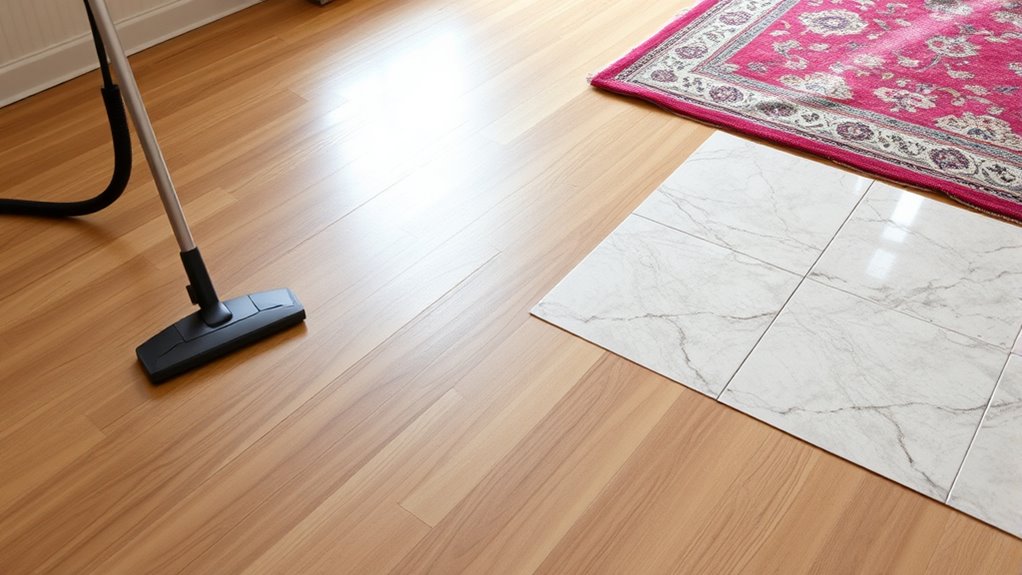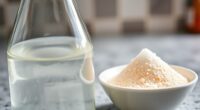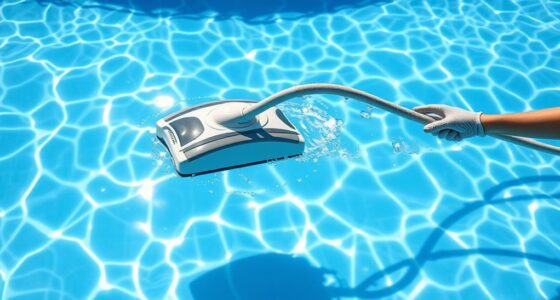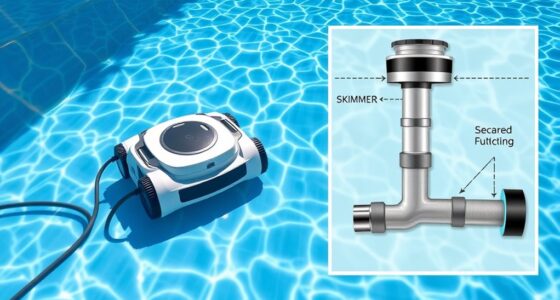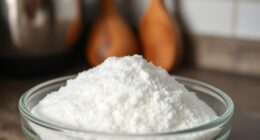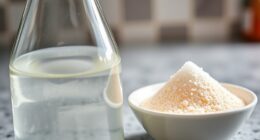To keep your floors spotless, start by sweeping or vacuuming tile, hardwood, and carpet regularly to remove surface dirt. Use appropriate cleaning solutions: a gentle tile cleaner for tiles, a pH-neutral cleaner for hardwood, and a quality carpet cleaner or steam method for carpets. Act quickly on spills and stains, and avoid harsh chemicals. For detailed tips on each surface, follow along for expert advice that will help you maintain your floors beautifully.
Key Takeaways
- Sweep or vacuum each surface regularly to remove loose dirt and debris before cleaning.
- Use appropriate cleaning solutions: gentle tile cleaner for tile, pH-neutral for hardwood, and carpet-specific cleaners.
- Avoid excess moisture; wring out mops and use minimal water to prevent damage to grout and wood.
- Address stains promptly with suitable stain removers or baking soda pastes to prevent long-term discoloration.
- Deep clean carpets periodically with steam cleaning and reseal grout lines on tiles to maintain appearance and hygiene.
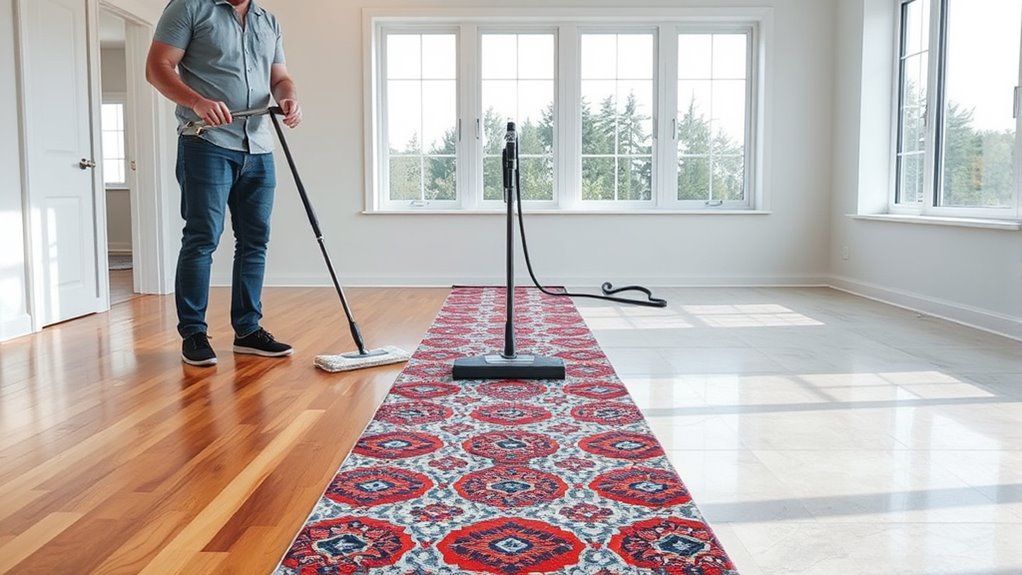
Are you wondering how to keep your floors looking their best? Maintaining clean, beautiful floors requires more than just a quick sweep. It involves mastering effective mopping techniques and understanding the best stain removal methods for different surfaces. When it comes to tile, hardwood, and carpet, each material demands specific care to preserve its appearance and longevity.
Start with tile floors. To achieve a gleaming surface, you need to use the right mopping techniques. Begin by sweeping or vacuuming to remove loose dirt and debris. Use a microfiber mop or sponge mop dipped in a mixture of warm water and a gentle tile cleaner. Avoid overly wet mops, as excess water can seep into grout lines and cause damage over time. When mopping, work in small sections, rinsing your mop frequently to prevent spreading dirt around. For stubborn stains or grout discoloration, employ specific stain removal methods such as a baking soda paste or commercial grout cleaner. Applying these solutions directly to stained areas and scrubbing with a soft brush can restore the tile’s original luster.
Start with sweeping or vacuuming before mopping tile for best shine.
Hardwood floors require a delicate touch. For routine cleaning, sweep or vacuum to remove surface dust and dirt. When mopping, opt for a damp (not soaked) microfiber mop, using a pH-neutral wood floor cleaner. Excess moisture can warp or damage wood, so always wring out your mop thoroughly. To tackle stains or sticky spots, use a soft cloth with a small amount of cleaner or a mixture of water and vinegar, but avoid harsh chemicals that can strip the finish. For stain removal, act quickly—blot spills immediately, and gently scrub with a soft cloth or sponge. For more stubborn stains, like ink or pet accidents, specialized wood floor stain removal methods may be necessary, such as using a wood-safe stain remover or a gentle sanding followed by refinishing.
Carpets demand a different approach. Regular vacuuming is essential, but deep cleaning involves extracting embedded dirt and stains. Use a quality carpet cleaner or rent a steam cleaner for periodic deep cleans. When dealing with stains, quick action is vital. Blot the spill with a clean cloth, then apply a carpet stain remover designed for the specific type of stain, whether it’s wine, coffee, or pet urine. Always test any stain removal method on a small, hidden area first to confirm it won’t discolor or damage the fibers. For persistent stains, professional cleaning might be your best bet. Remember, prevention is key—use doormats and encourage family members to wipe their feet to reduce dirt and stain buildup.
Frequently Asked Questions
How Often Should I Deep Clean My Tile Floors?
You should deep clean your tile floors at least once every 3 to 6 months, depending on mopping frequency and foot traffic. Regular mopping helps maintain cleanliness, but seasonal cleaning guarantees deep grime and buildup are addressed. If you notice stains or dirt buildup sooner, don’t wait—schedule a deep clean sooner. Consistent upkeep keeps your tile floors looking their best and prolongs their lifespan.
What Are Safe Cleaning Products for Hardwood Floors?
When choosing safe cleaning products for hardwood floors, you should look for eco-friendly solutions and chemical-free options. You can use a mixture of water and a few drops of gentle, plant-based dish soap or vinegar diluted with water. Avoid harsh chemicals like bleach or ammonia, as they damage the finish. Always test a small area first, and opt for products labeled safe for hardwood to keep your floors looking their best.
How Can I Remove Stubborn Carpet Stains Effectively?
Think of stubborn carpet stains as hidden treasures that need careful excavation. To effectively remove them, try stain removal techniques like blotting with a mixture of water and mild detergent or using a commercial carpet cleaner. For tough spots, apply a vinegar and baking soda paste and gently scrub. These carpet cleaning tips will help lift those persistent stains, restoring your carpet’s beauty and making your space feel fresh again.
Is Steam Cleaning Safe for All Types of Flooring?
You wonder if steam cleaning is safe for all flooring types. While steam cleaning safety is generally high, it depends on flooring compatibility. For instance, it’s safe for tile and vinyl but may damage hardwood if not used properly. Always check manufacturer guidelines and test a small area first. This way, you guarantee your floors stay clean without risking damage from improper steam cleaning.
How Do I Prevent Scratches on My Hardwood Floors?
You might think scratches are inevitable, but with proper care, you can keep your hardwood floors pristine. Use area rugs in high-traffic spots and furniture pads to prevent damage. Regularly sweep or vacuum to remove grit that causes scratches. Be cautious when moving furniture—lift, don’t drag. These simple steps protect your floors, ensuring they stay beautiful and scratch-free for years to come.
Conclusion
With the right techniques, you can keep your floors looking pristine and extend their lifespan. Don’t worry if some stains or scratches seem tough at first—you’ll get better with practice, and using the proper products makes a big difference. Remember, consistency is key. Even if your floors aren’t perfect right away, sticking to these tips guarantees they stay beautiful and durable over time. Trust your efforts—you’re capable of maintaining stunning floors effortlessly.

